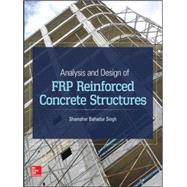The Most Complete FRP Reinforced Concrete Structure Analysis and Design Guide
This comprehensive reference provides proven design procedures for the use of fiber-reinforced polymer (FRP) materials for reinforcement, prestressing, and strengthening of reinforced concrete structures. The characteristics of FRP composite materials as well as the latest manufacturing techniques are discussed. Detailed illustrations and tables, design equations, end-of-chapter problems, and real-world case studies are included in this authoritative resource.
Analysis and Design of FRP Reinforced Concrete Structures covers:
- Material characteristics of FRP bars
- History and uses of FRP technology
- Design of RC structures reinforced with FRP bars
- Design philosophy for FRP external strengthening systems
- Durability-based design approach for external FRP strengthening of RC beams








